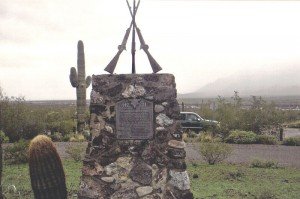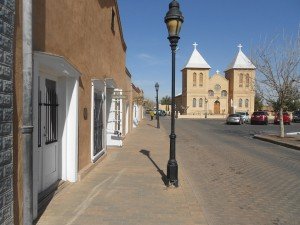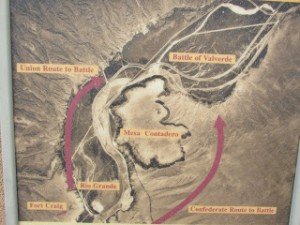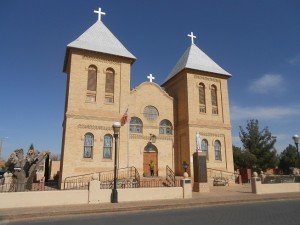In regards to the American Civil War there are several historic and unique travel stops for those planning a trip through the western U.S. If you’re looking for a unique trip idea in the West then trips to western Civil War sites might be just the thing.

Western Civil War trips allow one to gain a different perspective of the overall strategy of the opposing sides and learn about some of the key engagements that occurred far away from the much publicized battlefields of Gettysburg and Shiloh.
Confederate activity in the West was primarily found in the Southwest. Why? The answer is that the American southwest had a good many Confederate sympathizers who had moved there from both Texas and other southern states and reaching a Pacific port such as San Diego could aid the Confederate cause greatly.
Below is a description of several of the sites which you may want to consider adding to your vacation trip planner. As with most historic sites they are either free or inexpensive to visit and provide both a fun and educational experience for the entire family. You’ll be able to take a trip back into history with great photo opportunities.

The Westernmost Battle / Battle of Picacho Pass
That extreme southwest corner of the continent, while far removed from Dixie, was a Confederate sympathizer stronghold. The majority of the people who had migrated there were from the Old South and from Texas. The area was fairly neglected by the federal government and for the most part lawless so there were few reasons for strong allegiance to the Union.
John Robert Bayler was a key Confederate military figure in the New Mexico Territory. In 1861 he organized troops to fight southwest Union forces and after some success overtaking Union outposts declared himself military governor of the”new” Arizona Territory, which represented the southern part of present day New Mexico and Arizona.

Baylor appointed a cabinet and the Confederate Congress confirmed his position. He referred to Tucson as the western capitol of the Arizona Territory and Mesilla (present day Mesilla NM) the eastern capitol. .
The initial Confederate successes in Arizona turned against them due to the efforts of a Union general by the name of James H. Carleton, pictured right. In 1862 Carleton marched the 1st California Volunteers from Fort Yuma eastward toward Texas. He linked up with Union General Canby in New Mexico and the Confederate threat in the territory was largely eliminated.
It was during this expedition that the Battle of Picacho Pass took place. On April 15th, 1862 twelve troopers and a scout of the 1st California Volunteer Cavalry led by a Lt. James Barrett was scouting the pass looking for rebels. They came across three Confederate pickets and, against his orders to wait for the main Union column to join him, attacked the pickets. Barrett failed to see seven other Confederates hiding nearby and when they opened fire Barrett and two of his men were killed.
Barrett made the same mistake that George Armstrong Custer made 14 years later but on a much smaller scale. After the ninety minute fight both the Union cavalry and the rebels retreated. The rebels retreated east to Tucson and warned of the advancing Union forces. Rather than stay and fight, the Confederates retreated eastward and left the strategic town of Tucson wide open for Union occupation.

The Battle of Valverde and Fort Craig
The Battle of Valverde took place on February 21, 1862 and lasted the entire day. This represented a big victory for the Confederates and they did move northward from there to capture both Albuquerque and Santa Fe. After the Battle of Valverde the Union troops involved retreated back to Fort Craig which was not attacked. The Battle of Valverde is considered the largest Civil War battle in the southwest. The battle site is about seven miles north northeast of the fort and on the east side of the Rio Grande.
Eventually, Sibley and his forces were defeated further north at the historic Battle of Glorieta Pass located just to the east of Santa Fe along the old Santa Fe Trail. The ultimate goal of the Confederates was to attempt to capture Fort Union further north and the Colorado gold fields further north yet. Stopping this Confederate advance was why the Battle of Glorieta Pass was so significant for the Union.
See the Trips Into History articles on the links below…
The Confederates Who Fled to Mexico

Mesilla New Mexico / Confederate Stronghold
For years during the late 1850’s there were several efforts by people in the southern part of the territory to carve out their own government as the “Arizona Territory“. This actually occurred when the Confederates invaded and took temporary control of southern New Mexico Territory naming Mesilla it’s capital. A good many civilians who occupied the Mesilla Valley were Confederate sympathizers. The local Mesilla newspaper ran editorial after editorial supporting the southern cause as well as a push for a new Arizona Territory.
This all went on while the Apache Wars were in full swing. If anything, the Civil War and the temporary withdrawal of U.S. troops made the Apache matter much worse for Mesilla Valley residents. It seems that the Confederates had no better luck, and probably worse luck, than that of the Union forces in trying to quell the Apache raids.

Historic Mesilla NM
When you drive to old Mesilla, one of the first things you’ll notice is the beautiful cathedral on the north end of the plaza.This is the Basilica of San Albino.The church was originally built of adobe in 1855 and the current structure was erected in 1906. The church was designated a basilica in 2008.
Another very interesting and historic structure is the old home of Colonel Albert Jennings Fountain. Colonel Fountain moved to Mesilla in 1873 and practiced law. He served as a member of the territorial legislature, a judge, a special prosecutor, a district attorney and a deputy court clerk. Fountain was a staunch Republican. The old Colonel Albert Jennings Fountain family home was located two blocks northwest of the Mesilla plaza. The restored and renovated home is now privately owned.
Both New Mexico and Arizona are filled with historic sites that tell the story of the Civil War in the Southwest. In addition to being able to learn more about this period of American history, the scenery is spectacular and you’ll have plenty of great photo opportunities.
(Article and photos copyright 2014 Trips Into History. Photo of Picacho Pass Monument in the public domain)
